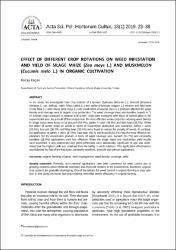EFFECT OF DIFFERENT CROP ROTATIONS ON WEED INFESTATION AND YIELD OF SILAGE MAIZE (Zea mays L.) AND MUSKMELON (Cucumis melo L.) IN ORGANIC CULTIVATION
Abstract
In our study, we investigated how crop rotation of a spinach (Spinacia oleracea L.), broccoli (Brassica oleracea L. var. italica), vetch (Vicia sativa L.) and barley (Hordeum vulgare L.) mixture and faba bean (Vicia faba L.) with maize (Zea mays L.) and muskmelon (Cucumis melo L.) products affected the weed density and coverage area in organic crop production. The weed coverage areas and densities (weeds m(-2)) of summer crops produced in rotation with winter crops were compared with those of control plots in the experimental area. As a result of this comparison, the most effective winter crops for reducing weed density in silage maize were found to be broccoli (50.4%), barley + vetch (48.3%) and faba bean (45.3%). When the effect of winter crops on weeds in terms of muskmelon production was examined, barley + vetch (53.2%), broccoli (36.1%) and faba bean (33.4%) were found to reduce the density of weeds. In contrast, the application of barley + vetch (67.0%), faba bean (65.3) and broccoli (62.0%) was the most effective applications for the muskmelon product in terms of weed coverage area; spinach (24.7%) and constantly weedless (16.8%) applications were less effective. When the silage maize and muskmelon yield results were examined, it was determined that yield differences were statistically significant. It was also determined that the highest yield was obtained from the barley + vetch rotations. This application effectiveness was followed by that of the faba bean, constantly weedless, broccoli and spinach applications.


















